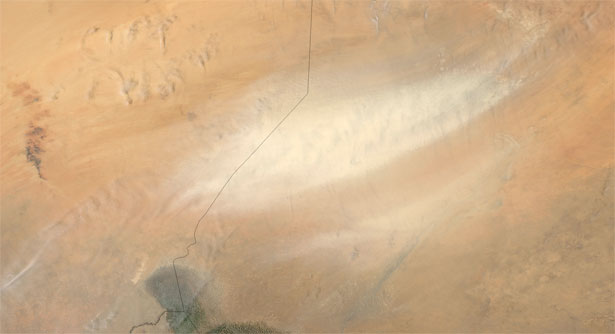
This is probably the most amazing thing I learned all weekend. The Amazon rainforest—with all its plant and animal life, and all its astounding biodiversity—could not exist as we know it without the patch of African desert pictured above.
The rainforest is amazing, but the soil it produces isn't very nutrient rich. All the minerals and nutrients that fertilize the rainforest have to come from someplace else. Specifically: Africa. Scientists have known for a while that this natural fertilizer is crossing the Atlantic in the form of dust storms, but science writer Colin Schultz ran across a 2006 paper in the journal Environmental Research Letters that not only produces evidence for a much larger trans-oceanic transfer of dust than was previously assumed ... it also pinpoints the exact (and astoundingly small) location where all the fertilizer in the Amazon is coming from.
The research paper, itself, is pleasantly readable, as far as these things go, so I'm going to quote directly from it. One quick note before I launch into this quote. The authors are measuring the mass of the dust in teragrams (or Tg). As you're trying to wrap your head around this, it might be helpful to know that 1 Tg = 1 million tons.
A total of 140 (± 40) Tg is deposited in the Atlantic ocean and 50 (± 15) Tg reach and fertilize the Amazon basin. This is four times an older estimate, explaining a paradox regarding the source of nutrients to the Amazon forest. Swap et al suggested that while the source for minerals and nutrients in the Amazon is the dust from Africa, it was estimated that only 13 Tg of dust per year actually arrive in the Amazon. However, they pointed out that 50 Tg are needed to balance the Amazon nutrient budget.Basically, these 2006 calculations account for all the fertilization needs of the Amazon, while previous calculations left a weird gap in between the amount of dust the rainforest needed and the amount the scientists thought was getting there.
Here we show a remarkable arrangement in nature in which the mineral dust arriving at the Amazon basin from the Sahara actually originates from a single source of only ~ 0.5% of the size of the Amazon: the Bodélé depression. Located northeast of Lake Chad (17°N, 18°E) near the northern border of the Sahel, it is known to be the most vigorous source for dust over the entire globe.
Also: The place the dust is coming from is a single, highly specific region. As Alexis Madrigal pointed out at The Atlantic, we're talking about a patch of desert only 1/3 the size of Florida supplying the nutrient needs of a jungle that is roughly the same size as all 48 contiguous United States. Mind, blown.
Read the full research paper at Environmental Research Letters
Check out The Atlantic's write up on this, including a satellite photo of the dust storms in question.

No comments:
Post a Comment